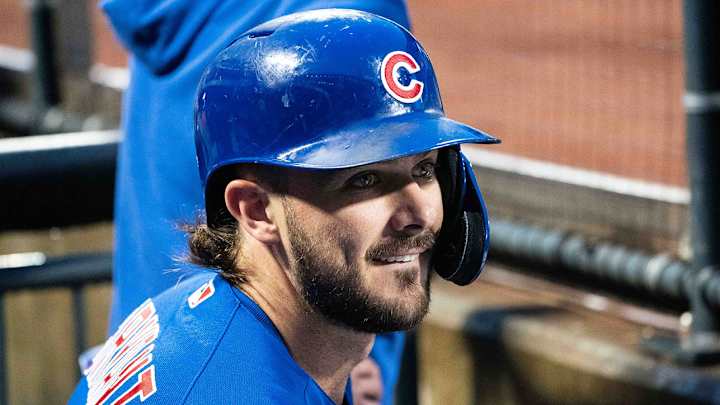Cubs Face Franchise-Altering Decisions This Winter

Theo Epstein’s resignation as the Cubs’ president of baseball operations signified a turning point for the organization. More so than any individual player or manager, the resurgence of the Cubs over the last decade was because of Epstein.
Make no mistake, 2021 is a transition year for the Cubs; what they do this offseason will shape their trajectory for the next decade. Sentimentality now will be the difference between nostalgia and jubilation five years from now.
The Cubs have three main decisions to make in the coming months. Let’s explore each of them:
1. Trade Kris Bryant
This seems to be the move the Cubs are most likely to make this offseason if they choose to break up their core. Bryant is coming off his worst season (73 OPS+), though that can surely be written off as an injury-filled, pandemic anomaly, and he is projected to make $18.6 million after arbitration.
Typically there would be many suitors for a former MVP going into his age-29 season at that price, even if it’s just for one year. However, plenty of teams, including the Cubs, are expected to cut costs this offseason. The financial outlook for next season is just as uncertain. How many teams will actually want to add nearly $20 million to their payroll, send away younger and cheaper players and risk losing Bryant to free agency come next winter? Not many. Potential trade partners include the Mets, Nationals, Dodgers, Blue Jays and Red Sox.
This year showed that the Cubs can win the NL Central despite career-worst seasons from Bryant, Javier Báez, Anthony Rizzo and Kyle Schwarber—all of whom are free agents next offseason. The division has no juggernaut, and the Cubs likely will contend next season with or without Bryant.
If they haven’t already, the Cubs need to figure out whether Bryant is in their long-term plans. The writing on the wall says he isn’t: not after he filed a grievance against the organization, alleging it had manipulated his service time to keep him under club control for an extra year; not when Chicago also needs to decide whether to extend or re-sign fan favorites Báez and Rizzo; not with the Cubs, for the second consecutive offseason, entertaining trade offers for him.
Unless something changes, Bryant will not be with the Cubs in 2022. Trading him this offseason ensures they get more than just draft-pick compensation in return when they lose him.
2. Trade Willson Contreras
Ahhh, now we’re getting spicy. Trading Contreras wouldn’t be a cost-cutting measure as much as a way for the Cubs to replenish their farm system. Contreras is under club control for two more seasons, and he is projected to make $6.2 million in 2021 after arbitration, according to Spotrac. That’s more than a bargain for one of the best catchers in baseball, at a time when good catchers, especially good offensive catchers, are rare. All the teams in the J.T. Realmuto sweepstakes would presumably also be interested in Contreras, who is much cheaper, slightly younger and not as much of a commitment.
Willson Contreras with an all-time bat flip 😱 pic.twitter.com/LwPC979r1d
— SportsCenter (@SportsCenter) September 26, 2020
The Cubs almost certainly would get a more valuable return for Contreras than Bryant because of cost, control and position (third base is a much deeper position than catcher). They also have good options to replace Contreras if they trade him. The Cubs are high on backup catcher Victor Caratini, who hit a .266/.348/.447 with 11 home runs in 95 games in 2019. One of Chicago’s top prospects is 21-year-old catcher Miguel Amaya, who could be ready for his MLB debut as soon as this upcoming season.
3. Add Depth, Specifically Starting Pitching
This is the least exciting option, but it’s not necessarily a bad one. The Cubs are losing three of their starting pitchers to free agency, but they’re retaining their two best: Yu Darvish and Kyle Hendricks. Alec Mills threw a no-hitter last year, and their projected fourth starter, as of now, is Adbert Alzolay—their No. 5 prospect, per FanGraphs.
To fill out the rotation, the Cubs could look to buy low on a veteran free-agent starter. Two suggestions: J.A. Happ and Cole Hamels.
Happ was the Yankees’ best starting pitcher last year not named Gerrit Cole. With the exception of a rough 2019, Happ has gotten better with age. Over the last five years—his age 32–37 seasons—he is 61–31 with a 3.77 ERA. If it’s worth anything, Happ is also from Peru, Ill., which is about two hours from Chicago, and went to college at Northwestern.
Injuries limited Hamels to one start last season with the Braves, but before signing a one-year deal last offseason with Atlanta, he had spent the last year and a half with Chicago. The Cubs acquired him from Texas in late July 2018, and in 39 starts with them, he went 11–10 with a 3.30 ERA.
Neither of these lefties are long-term answers for the Cubs, but they could be short-term, low-cost solutions to reinforce the back of the rotation.
